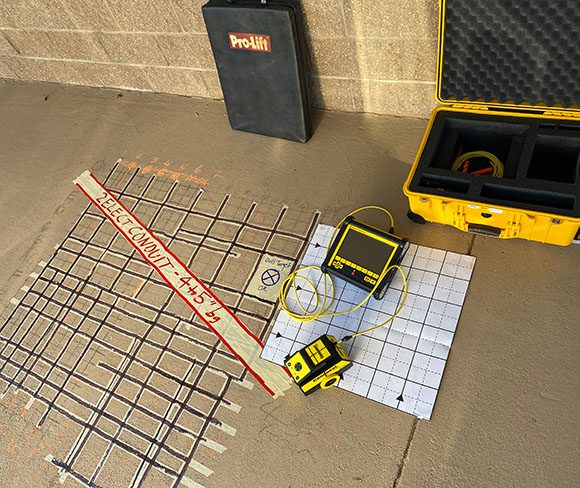Utilizing Development: RainierGPR Concrete Scanning for Precision Results
Wiki Article
Checking Out the Depths: A Comprehensive Guide to Concrete Scanning and Its Diverse Applications
In the world of building and framework growth, the precise process of concrete scanning holds a pivotal function in ensuring the architectural stability and safety and security of jobs. As technology continues to advance, the applications of concrete scanning have broadened far beyond simple surface-level analyses.Importance of Concrete Scanning
Recognizing the significance of concrete scanning is crucial in ensuring the safety and security and integrity of frameworks throughout building and construction and renovation jobs. Concrete scanning uses advanced modern technologies such as ground-penetrating radar (GPR) and electromagnetic induction to identify embedded things, spaces, or various other abnormalities within concrete structures.Additionally, concrete scanning plays a crucial function in ensuring compliance with building ordinance and guidelines that mandate the defense of existing structural elements throughout building activities. By precisely mapping out the internal structure of concrete, scanning technologies allow construction specialists to make enlightened choices that maintain the structural stability and toughness of buildings and facilities projects. Basically, the relevance of concrete scanning depends on its capacity to secure both the architectural honesty and the personnel included in building and construction endeavors.
Technologies Made Use Of in Concrete Scanning
Concrete scanning relies on sophisticated modern technologies such as ground-penetrating radar (GPR) and electromagnetic induction to accurately detect embedded things and abnormalities within concrete frameworks. Ground-penetrating radar runs by releasing high-frequency electro-magnetic waves into the concrete. When these waves run into different products or gaps within the concrete, they jump back to the surface area, allowing the GPR system to produce a thorough subsurface photo. This modern technology is specifically reliable in finding rebar, post-tension cords, conduits, and various other things installed in concrete.Electromagnetic induction, on the other hand, works by producing electromagnetic areas around a concrete framework with a transmitter coil. When metal things are existing within the concrete, they interrupt these electromagnetic areas, creating eddy currents to move via the steel. By measuring the changes in the magnetic fields with a receiver coil, the system can determine the area of metallic items in the concrete.
These advanced modern technologies play an essential duty in non-destructive screening, ensuring the safety and integrity of concrete frameworks in various industries.
Applications in Construction Sector
Within the building sector, concrete scanning innovation locates varied applications that boost task performance and security. One crucial application is the discovery of rebar, post-tension wires, and other ingrained items prior to boring or reducing into concrete structures. By properly mapping out these aspects, building teams can stay clear of pricey damages, ensure structural stability, and avoid prospective security risks. Furthermore, concrete scanning is made use of for locating spaces, such as air pockets or areas of wear and tear within concrete, which can jeopardize the general toughness of a framework. By recognizing these spaces beforehand, construction experts can take required measures to address them and keep the longevity of the structure. Concrete scanning plays an important role in quality control by verifying the density of concrete covers over reinforcement, guaranteeing compliance with design requirements and requirements. Generally, the applications of concrete scanning in the building sector add considerably to enhancing project process, here decreasing threats, and delivering high-quality outcomes.
Safety And Security Benefits of Concrete Scanning
In the realm of building security, the implementation of concrete scanning modern technology offers a vital advantage in preemptively identifying possible hazards and strengthening architectural stability. By making use of advanced scanning approaches such as ground-penetrating radar (GPR) and electro-magnetic induction, construction groups can precisely situate rebar, post-tension cables, avenues, and other hidden things within concrete structures. This positive method substantially minimizes the risk of accidental strikes during boring, reducing, or coring tasks, consequently avoiding costly problems, injuries, and task hold-ups.Furthermore, concrete scanning enhances employee safety and security by offering real-time information about the structural problem of concrete aspects. By resolving prospective safety and security worries promptly, concrete scanning adds to developing a secure functioning setting and reducing the chance of architectural failings or crashes on building and construction sites.
Future Fads in Concrete Scanning
Emerging advancements in scanning innovation are poised to transform the field of concrete examination and evaluation. One significant fad that published here is obtaining traction is the integration of expert system (AI) and device discovering algorithms right into concrete scanning tools. By taking advantage of the power of AI, these systems can evaluate vast amounts of information collected throughout scanning procedures to give more in-depth and exact understandings into the problem of concrete frameworks. This can aid in identifying covert issues, anticipating potential structural failings, and even advising upkeep approaches.An additional significant fad is the development of even more mobile and straightforward scanning tools. Miniaturization of scanning equipment enables less complicated accessibility to confined areas and remote locations, making assessments extra detailed and efficient. Additionally, developments in cordless interaction innovations allow real-time information transfer and evaluation, facilitating quicker decision-making processes.
Moreover, there is an expanding concentrate on sustainability in concrete scanning modern technologies - RainierGPR Concrete Scanning. Manufacturers are progressively including environment-friendly materials and energy-efficient features right into their tools to lower ecological influence. These future patterns are set to enhance the effectiveness, precision, and sustainability of concrete scanning techniques, shaping the sector's future landscape
Verdict
To conclude, concrete scanning plays a vital function in the building market by making sure the safety and performance of various projects. By making use of innovative technologies, such as GPR and radar imaging, experts are able to accurately discover possible threats within concrete frameworks. The applications of concrete scanning are substantial and remain to advance, making it an important tool for keeping the integrity of buildings and facilities. As innovation developments, the future of concrete scanning holds appealing developments for enhancing construction procedures.

Report this wiki page